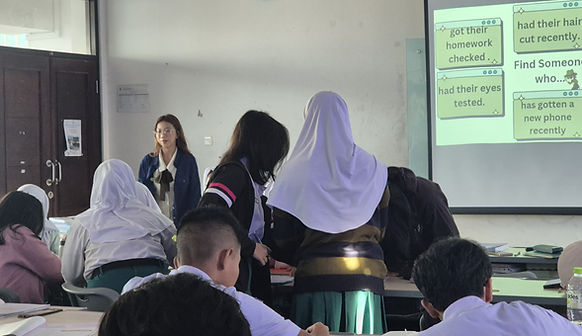


TEACHING PRACTICE
My coordinating teacher provided thorough guidance, especially since we were engaged in collaborative teaching. During my first week of classes, she translated some instructions that students struggled to understand, as not all of them were fluent in English. Based on my observations, only about 2 to 4 students were fluent, while around 6 to 10 could understand and speak to some extent. The rest either had basic speaking skills or could not speak English at all. My coordinating teacher also provided feedback on my teaching, which was valuable in ensuring smooth classroom instruction.
In my second week of teaching practice, I was required to teach independently while my coordinating teacher observed. This allowed us to identify areas for improvement that I could implement. Later, I transitioned to fully independent teaching without Ms. Julie’s supervision, and in the first week of this stage, I conducted my teaching demonstration.

Orientation
During the orientation, we were introduced to our designated cooperating teachers, who also provided an overview of our tasks for the duration of our stay. My coordinating teachers, Ms. Nurbi and Ms. Juliantika Widya, discussed my schedule in detail. I will be observing, co-teaching, and handling three classes: XI-Bilingual 1, XI-Bilingual 2, and XI-Bilingual 3.
Procedures of Teaching
I follow the procedure from my lesson plan when I am teaching and it was listed below:
Greetings and Classroom Management
-
This includes checking the attendance,
Review of the Previous Lessons
-
Giving short tasks in order to recall their knowledge from the previous lessons.
Discussion
-
15 minutes discussion of the lesson
Application
-
Guided practice of what they have learned.
Generalization
-
Wrap up of the whole discussion and practice of lesson.


Time Management and Organizing Activities
Each of class session contains 80 minutes. This was enough to finish 1 to 2 lessons. Since they were more focused in activities, I give 15 minutes for the discussion while the remaining time will be for their practice exercises and assessments. Giving more time with their assessments help the students to effectively attain the teaching objectives of the teachers. The students will be assessed individually and ensure that each of them learned from the lessons. Organized lesson plans in each class were a must! With my prepared lesson plan, I can conclude the weaknesses and strength of my teaching strategies and identify what and why it did not go well. I can also track down the focus of each lesson, skills that I aim to improve more, and knowledge that I wanted them to gain.

Classroom Management
In order to effectively manage the classes that I have handled, the following were my classroom management strategies and the future SEA teachers must also have:
-
Since I am a foreign student-teacher, some of them may not yet comfortable to participate. They were hesitant to share their ideas. Thus, I made sure that I established a positive and safe environment, so that they can be more comfortable to share their insights.
-
In connection with that, it was very important that I build connections with my students. Thus, I can easily communicate them not only the lesson but also clear expectations inside the classroom.
Assessing students’ progress was one of the classroom management strategies which can help students to improve. Not all of them had the same pace in learning since not all of them were fluent in speaking English. Thus, I need to assess each of the students’ progress by providing them individual feedback and assistance.
Problem-solving while teaching and staying in the designated school
One of the key improvements I made during my month of teaching practice; based on Ms. Juliantika’s observations, was in delivering clear instructions to enhance student learning. To address these, I focused on clarity and engagement in my teaching approach.

1
Enhancing Instructional Clarity
-
Simply stating instructions was not always effective, so I simplified my language and used step-by-step explanations.
-
Instead of just verbal instructions, I incorporated visual aids and examples to help students understand tasks better.
2
Using Illustrations and Examples
-
Students responded better when I demonstrated activities rather than just explaining them.
3
Effective Review Strategies
-
Instead of merely asking students to define concepts, I engaged them in short tasks that required application of what they learned.